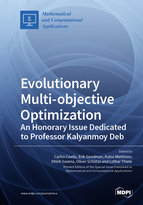Evolutionary Multi-objective Optimization: An Honorary Issue Dedicated to Professor Kalyanmoy Deb
A special issue of Mathematical and Computational Applications (ISSN 2297-8747).
Deadline for manuscript submissions: closed (1 November 2022) | Viewed by 26306
Special Issue Editors
Interests: multi-objective optimization using metaheuristics; bio-inspired metaheuristics for optimization (e.g., evolutionary algorithms, artificial immune systems, particle swarm optimization)
Interests: evolutionary multi-objective optimization
Interests: multiobjective optimization; interactive methods; evolutionary algorithms; visualization; decision analytics and supports
Interests: evolutionary multi-objective optimization; multi-criteria decision making; AI assisted optimization
Interests: multi-objective optimization; evolutionary computation (genetic algorithms and evolution strategies); numerical analysis; engineering applications
Special Issues, Collections and Topics in MDPI journals
Special Issue Information
Dear Colleagues,
This Honorary Special Issue is dedicated to the 60th birthday of Professor Kalyanmoy Deb, a pioneer and highly impactful and influential proponent of Evolutionary Multi-objective Optimization (EMO) since 1994.
We are gathering contributions from collaborators, former students and scientists working on research areas most impacted by Professor Deb's work. We hence invite researchers to submit high-quality articles related (but not limited to) the following topics:
-Evolutionary multi-objective optimization (EMO):- multi-objective evolutionary algorithms;
- genetic operators;
- theory of EMO;
- performance indicators and proximity measures;
- archiving strategies;
- surrogate assisted optimization;
- integration of user preferences;
- many objective optimization;
- constraint handling;
- hybrid methods;
- test functions;
-Multi-criteria decision making (MCDM);
-Scalar optimization;
-Bi-level optimization
-AI-assisted optimization;
-Applications to real-world problems.
Both research articles and surveys are welcome. Accepted papers will be published free of charge.
Kalyanmoy Deb is currently a Koenig Endowed Chair Professor and University Distinguished Professor in the Department of Electrical and Computer Engineering at Michigan State University, USA, and holds additional appointments in Mechanical Engineering and in Computer Science and Engineering. Professor Deb's research interests are in evolutionary optimization and their application in multi-criteria optimization, modeling, machine learning, and multi-criteria decision making. He has been a visiting professor at various universities across the world, including IITs in India, Aalto University in Finland, the University of Skovde in Sweden, and Nanyang Technological University in Singapore. He was awarded the IEEE Evolutionary Computation Pioneer Award, the Infosys Prize, the TWAS Prize in Engineering Sciences, the CajAstur Mamdani Prize, the Distinguished Alumni Award from IIT Kharagpur, the Edgeworth-Pareto award, the Bhatnagar Prize in Engineering Sciences, and the Bessel Research award from Germany. He is a fellow of IEEE, ASME, and three Indian science and engineering academies. He has published over 550 research papers with Google Scholar citations of over 165,000 and with an h-index 126. More information about his research contributions can be found from https://www.coin-lab.org
Prof. Dr. Carlos Coello
Prof. Dr. Erik Goodman
Prof. Dr. Kaisa Miettinen
Prof. Dr. Dhish Saxena
Prof. Dr. Oliver Schütze
Prof. Dr. Lothar Thiele
Guest Editors
Manuscript Submission Information
Manuscripts should be submitted online at www.mdpi.com by registering and logging in to this website. Once you are registered, click here to go to the submission form. Manuscripts can be submitted until the deadline. All submissions that pass pre-check are peer-reviewed. Accepted papers will be published continuously in the journal (as soon as accepted) and will be listed together on the special issue website. Research articles, review articles as well as short communications are invited. For planned papers, a title and short abstract (about 100 words) can be sent to the Editorial Office for announcement on this website.
Submitted manuscripts should not have been published previously, nor be under consideration for publication elsewhere (except conference proceedings papers). All manuscripts are thoroughly refereed through a single-blind peer-review process. A guide for authors and other relevant information for submission of manuscripts is available on the Instructions for Authors page. Mathematical and Computational Applications is an international peer-reviewed open access semimonthly journal published by MDPI.
Please visit the Instructions for Authors page before submitting a manuscript. The Article Processing Charge (APC) for publication in this open access journal is 1400 CHF (Swiss Francs). Submitted papers should be well formatted and use good English. Authors may use MDPI's English editing service prior to publication or during author revisions.











